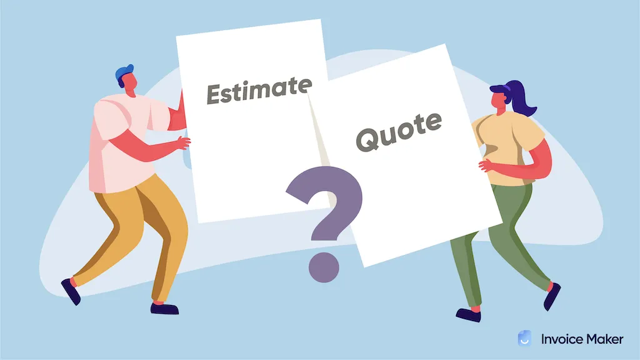Quote vs. Estimate: When and How to Use Each for Your Clients

People who don’t work for themselves or who are just starting out as small business owners often confuse an estimate and a quote. This misunderstanding makes sense, considering both documents indicate the same thing: how much a service or job will cost.
Make a Free Invoice NowEstimates and quotes help customers to decide whether or not to proceed with a purchase. They differ from invoices and receipts in that they’re issued prior to billable work beginning. They’re both an indication of the bill that’s ultimately coming.
But they’re not actually the same thing. Even if you’re not issuing estimates and quotes, you’ll probably, at some point, receive one from someone who is selling you a service. Let’s clarify the difference between the two documents so that next time you get one you’re not confused.
Estimate
An estimate is pretty much what you might expect it is: a good guess. This document communicates a supplier’s rough idea of what a job will cost. It does not reflect an exact, precise price. It’s expected that the price won’t change too dramatically–15% is a reasonable margin–but it’s also expected that the price reflected on an estimate will fluctuate.
An example of a situation in which you might need an estimate is when you’re applying for a permit to renovate a house and you need to show the local government what the renovation will cost. You might need a general idea of what kind of money you’ll have to spend, but at this stage you don’t have a firmed-up vision of exactly what the renovation will entail. The contractor may not be able to nail down a firm price at this point, but they will be able to approximate a general price range via an estimate.
Quote
A quote, on the other hand, shows a precise figure. This is a document that tells a client exactly what something will cost and breaks down the proposed project into its component parts. A quote will itemize the labor, time, and materials needed to complete the work.
Preparing a quote requires time and experience. Often, the process of quoting involves corresponding with subcontractors and sourcing other quotes from suppliers who will be contributing to the job. This is a lengthier, more detail-oriented approach to giving a customer a price.
So, when do you use an estimate and when do you use a quote? The answer to this question could save you a lot of confusion and help you to avoid conflict, whether you’re selling a service or buying one.
When to Send Each
Estimates and quotes are used by people who do work that varies based on what clients want. You wouldn’t use an estimate or a quote if you sold products at a retail store; you’d simply price items and all customers would pay that exact price. But if you’re building homes, you’re going to have to take into account a range of factors, from square footage to location to a client’s design preferences. You can’t just list the price of building a home on your website. You have to figure that out before beginning each project.
However, the circumstances in which you’d use an estimate are different than those in which you’d use a quote. Let’s talk about those.
You’d send an estimate when you don’t yet know what the components of a project will cost, when there are subcontractors involved, when you know there will be unanticipated costs, or when you don’t have all the information you’ll need to determine an exact price. You might also use an estimate when the job is small and simple, meaning it won’t require extensive resources.
Say, for example, you’re a general contractor being asked to provide an estimate for what building a house will cost. Your client still hasn’t engaged an architect or designer and doesn’t really know what the house is going to look like yet. You can’t issue an exact quote, as there are many variables that could affect the final price. In this situation, you might send the customer an estimate.
This is different than, say, a freelance writer who’s being asked to write a specific number of words. The writer would be more easily able to gauge what the project will cost, based on a set rate or a general idea of how much time an article of this length would take. In this type of situation, a quote makes more sense.
How to Send an Estimate
Whether you handwrite, type, or purchase an invoicing software, what’s most important is that your estimates look professional. It’s also important to label your document clearly as an “estimate.” This way, the client doesn’t miscategorize it as a quote.
Include the name of your business and your contact information, as well as a date and reference number. Include the information you have already—for example, a general breakdown of the materials involved in the project—and the price estimate.
To summarize, your estimate should contain the following:
- Contact details for your company, including address, phone number, and email address
- Company logo, if applicable
- Estimate number (for ease of reference)
- Contact details for client, including address, phone number, and email address
- Date of issue
- Brief description of service to be provided
- Cost estimate
How to Send a Quote
A quote will contain more information than an estimate. Include all the information an estimate contains but also itemize each component of the project and, in another column, include its price. If any VAT or taxes apply, include those, too.
Most contractors include a date on which the quote expires. This is a means of hedging against the possibility of prices for certain products rising, for example, or the impact of other extenuating factors.
So, to recap, make sure your quote includes the following:
- Contact details for your company, including address, phone number, and email address
- Company logo, if applicable
- Quote number (for ease of reference)
- Contact details for client, including address, phone number, and email address
- Date of issue
- Date of expiration
- Itemized list of project components, including labor and materials
- Terms and conditions, including payment terms
- A note thanking the client for the business opportunity
Quotes can be created manually, in a word processing program such as Microsoft Word or Google Docs, but for ease and simplicity of use, check out digital tools such as the ones provided by Invoice Maker.
Potential Drawbacks of Each
Most people who regularly use estimates and quotes will agree that they can feel laborious. In fact, the amount of work that can go into creating an estimate or quote is significant enough to warrant an entire profession, known as cost estimation. Cost estimators gather and analyze data to estimate the time, materials, and labor involved in a project. Usually they specialize in a specific industry.
Both estimates and quotes take time to prepare that doesn’t actually count as billable time spent on the project. It’s frustrating to spend time on an estimate or quote that ultimately gets rejected by a client.
A drawback that’s unique to an estimate is that there’s potential for disputes over the ultimate price charged. An estimate might miss the mark, and when the customer receives the bill, they might be unpleasantly surprised. This is why it’s a good idea to follow up with a quote after the client has accepted an estimate.
The primary drawback of using a quote, on the other hand, is that it’s fixed. This means that if unanticipated costs arise, they can’t be integrated into the total cost of the project.
While there are some risks associated with using both estimates and quotes, they are also standard practice in many industries. By issuing them to clients, businesses communicate that they are professional and organized.
Benefits of Using Estimates and Quotes
Offering professional estimates and quotes gives customers a sense that a business is legitimate and worth engaging. Because both estimates and quotes precede a job, meaning the job isn’t yet secured, it’s important to convey the right image at the outset in order to secure the sale.
Preparing estimates and quotes is also an opportunity to get a better understanding of what a job will entail. This can help a service provider with organizing and scheduling multiple projects. Often a freelancer or small business owner is juggling various jobs simultaneously, so getting a full sense of how much time and dedication a specific project will require helps with time management and updating other clients.
Are Estimates and Quotes Binding?
An estimate is not binding; a quote can be. It’s important to understand that according to contract law, a quote is not, in and of itself, a formal contract. However, if the client accepts the quote, then it becomes legally binding.
This means that when the supplier emails a quote to a client, it’s technically not a contract yet. When the client responds affirmatively and accepts the quote, now it’s binding. In order to become a formal contract, a quote must indicate who is supplying the service, who is receiving the service, and a clear offer; there must also be written acceptance of the approximated price.
Because a quote can easily become a contract, it’s best to use an estimate if you think the project might incur more time or supplies than you originally anticipated.
Related Documents
Estimates and quotes come before a project begins. They get you thinking about what the work is going to entail and how much time and how many of your own resources you’ll have to devote to it. They also help you to manage your customer’s expectations. So what happens after you’ve landed a gig and completed the work? You’ll need to get paid. Invoices and receipts are the two documents you’ll use most commonly during this phase of the process.
These include some of the same information that estimates and quotes do, including contact details for the contractor and the client, a date, and a reference number. Let’s take a look at how they differ from estimates, quotes, and each other.
Invoice
An invoice is a document that requests payment for a service that has already been rendered. It contains an itemized breakdown of what time, materials, and labor were involved in the project and lists a price for each component.
Receipt
A receipt is often confused with an invoice. However, there’s a crucial difference. Whereas an invoice is asking a customer to pay, a receipt is acting as proof that the customer did pay. You get a receipt at the store when you purchase your items, and you can use this to track your expenses and provide proof of purchase for tax purposes. Many service providers issue receipts once their invoices have been paid, though some don’t, preferring to use their invoices to document cash flow instead.
If you’re starting out as a freelance or small business owner, it’s important to know how to set a rate. It’s equally important to know how to communicate that rate to a customer using an estimate or a quote. Anyone who’s learned the hard way how important quoting is, perhaps by getting entangled in an expensive legal battle with a client, will vouch for that statement.
Instituting systems that streamline the whole payment process for you can save you a lot of stress and conflict. Invoice Maker allows you to simply and easily generate estimates and quotes, and automatically converts them into invoices and receipts you can use once a project is complete.


